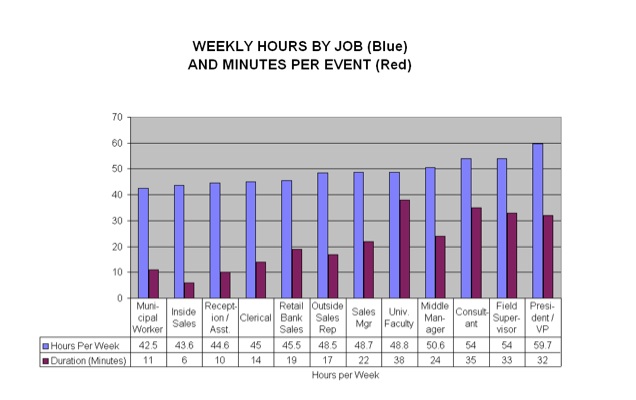by Charles Plant | Feb 8, 2012 | Management
Research from the National Bureau of Economic Research shows that U.S. corporate hierarchies have become flatter over the past two decades. Not only have CEOs been increasing the number of their direct reports but the number of middle managers has been declining.
“The number of managers in a company who report directly to the CEO has increased from an average of four in 1986 to an average of seven today. Rajan and Wulf concentrate on divisional managers — the lowest management rank with profit center responsibility and the position most consistently defined in the survey — and find that the number of division heads who report directly to the CEO has increased by 300 percent. The number of levels in the management hierarchy between division heads and CEOS has declined by 25 percent.” (National Bureau of Economic Research)
This flattening of the organization and increase in the number of direct reports has also added to the workload of the typical manager. Globalization and telecommuting has made it possible for these direct reports to be anywhere. Now a people manager not only has to cope with having more direct reports but he or she has a much more difficult job managing those people when they are removed form daily physical contact. The same problem holds true for other managers such as project and product managers.
by Charles Plant | Feb 6, 2012 | Management, Video
Lea Cameron went from working with small organizations to working at McGill University. In this video blog she discusses the implications of working with diverse teams.
http://vimeo.com/35916802
by Charles Plant | Feb 1, 2012 | Management
In 2010, Cisco conducted a worldwide study that found that three out of five workers believe that it is no longer necessary to be in the office to be productive. Furthermore, two thirds of the workers polled said they would take a lower paying job if it meant that they could have more mobility and flexibility. The knowledge revolution has made it possible for many employed individuals to telecommute.
Based on an American Community Survey for 2008, just over 2% of the U.S. employee workforce (2.8 million people, not including the self employed or unpaid volunteers) considers home their primary place of work. This is up from 2.3 million people in 2006. www.teleworkresearchnetwork.com/telecommuting-statistics. While these statistics represent individuals who work from home full time, there is an increasing number who work from home at least one day of the week. There are about 15 to 20 million road warriors who are mobile workers. Another 15 to 20 million people work at home at least part of the time. Of US employers, 42% say they have allowed staff to work remotely this year—up from just 30% in 2007. (WorldatWork 2008 survey of 2,288 U.S. employers)
by Charles Plant | Jan 25, 2012 | Management
This trend of work going home and home coming to work has only extended the workday and in total made the amount of time worked greater. A study of work time hours shows that those people who supervise employees have longer work hours than those who do not.
“The average for all full-time employees is 46.7 hours per week. Within this group, municipal workers generally work 42.5 hours. Many of these are unionized employees with contracts that specify their maximum number of hours. Once negotiated, they generally stick to this The other jobs that are lower than the average do not have a travel component. Employees stay at one location. Those who are above average have greater responsibilities, more travel, and more people management as part of their jobs. The chart below shows work hours per week (blue bars). Those who supervise employees have longer work hours and occasions than those who do not. Independent consultants are an exception. Unlike most other employees, their income is directly related to hours worked – they have a different incentive from employees to work long hours.” http://getmoredone.com/2010/08/hours-worked-by-job/

by Charles Plant | Jan 20, 2012 | Management
In a twist on an old practice, the Globe has an article in it today about Bottom-to-top Mentoring. The idea behind reverse mentoring is for junior mentors to help senior leaders get a better idea of newer issues and technologies. Reverse mentoring on such issues as social media, diversity, and understanding younger employees will enable senior leaders to get a better handle on up and coming trends. Interesting spin on how to teach an old dog new tricks.
by Charles Plant | Jan 18, 2012 | Management, Video
If you’ve ever wondered why large companies are so slow to react and small one are so nimble, listen to Derek Fisher as he explains his Convoy Theory.
http://vimeo.com/35375972

